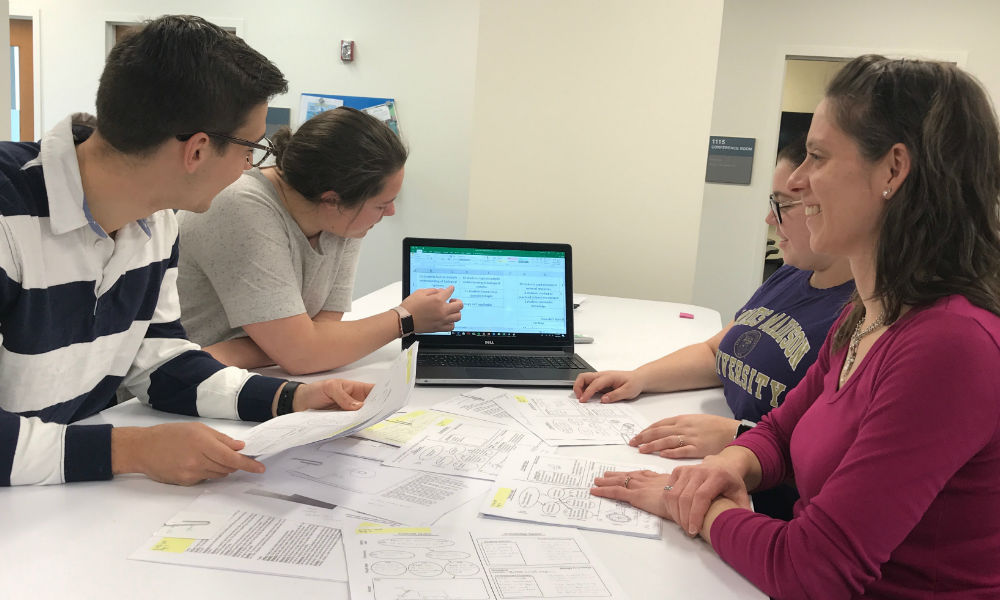Professor promotes bioinspired engineering
Engineering
SUMMARY: When it comes to engineering, the most innovative concepts can sometimes come from what nature has already created. Professor Jacquelyn Nagel uncovers such solutions through her internationally recognized research on the concept of "bioinspired design."
By Caroline Whitlow
“Bioinspired design is essentially taking information from nature to solve human problems. What makes it beneficial to engineering is that it’s another approach to problem-solving,” said Nagel. “As more engineering students are trained in multidisciplinary design innovation, they will create solutions that result in a sustainable future for society.”
Nagel, who has a background in electrical and mechanical engineering, first became involved with biomimicry as a Ph.D. student at Oregon State University. While working toward her degree in mechanical engineering, she served as a graduate assistant in the Design Engineering Lab.
One of Nagel’s first major projects in biomimicry involved developing a chemical sensor inspired by expansion and contraction within plant cells and substances in muscle fibers. Major companies like Rolls-Royce showed interest in the sensor, which could be created at the nano level and be embedded in products such as tailpipes to measure emissions.
“I still have that idea in my back pocket,” said Nagel. “If I just get the proper equipment and the time, I could make a prototype. I think it would be valuable.”
When Nagel came to JMU, she put the project aside and instead worked on curriculum development and teaching methods of bio-inspired design. Sophomore and junior engineering design courses now integrate the concept. Additionally, Nagel teaches an elective course dedicated solely to the subject.
One group of Nagel’s students combined their education surrounding bioinspired design with their passion for sustainability. The students wanted to find a way to make products utilizing multiple materials into single-material products, which would, in turn, make them more easily recyclable. Nagel oversaw the group as they developed a bioinspired bicycle helmet.
“I had an amazing student team working on this project. I had a biology student, an ISAT student and two engineering students. So it was just a perfect number, and they were all really excited about bioinspired design,” said Nagel. “I asked them how we can integrate biomimicry into manufacturing. They were interested in using green principles, especially the recycling aspect. We focused on the bike helmet and showed that we could decrease CO2 emissions by switching manufacturing methods and reducing the number of materials.”
Nagel recently presented a talk about teaching of bioinspired engineering at the International Workshop in Design Theory in Paris, France.
“Faculty at MINES ParisTech had seen my paper and invited me to speak at the conference in 2017. I had just had my daughter, so I asked them to consider me for this year. It worked out this time around,” said Nagel. “The talk was well-received. Interestingly, someone in the audience had a policy background. They were interested in how bioinspired design could be applied to policy design.”
Only a week after the workshop in Paris, Nagel traveled to Ohio to speak at the University of Akron. “This topic was more about how design theory impacts the field of bio-inspired design with a historical perspective. I wanted to add value to the audience’s knowledge because most of them had a biology background. I thought I could teach them something new by focusing on design.”
While in Ohio, Nagel collaborated with the NASA Glenn Research Center. Researchers at NASA hope to use a thesaurus she created in their new Periodic Table of Life database, or “PeTaL.” PeTaL will serve as a database of information on natural systems for both biologists and engineers. Nagel’s thesaurus translates terminology from engineering to the life sciences, and visa versa.
“Moving forward, I want to show how some of the work I’ve done can integrate into work on the forefront,” said Nagel. “University of Akron students want to collaborate on an ontology based on the thesaurus. There’s a lot that could happen with this work.”
Nagel hopes to introduce students of all majors to bioinspired design through a critical thinking General Education course.
“The Gen Ed coordinators reached out to faculty about creating a 300-level class focused on critical thinking and creativity,” said Nagel. “I thought this topic would be a great fit for that. I can see it being offered in the Gen Ed sequence so that students from across campus can be involved with this concept and bring unique perspectives.”
More about Nagel’s integration of bioinspired design into the curriculum can be found online.
